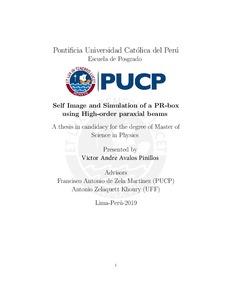| dc.description.abstract | From Maxwell equations (for a free of charge and current, isotropic and
homoge- neous medium) and the paraxial approximation, which is to
suppose the beam of light moves towards a preferred direction
(longitudinal propagation), we ar- rive at the paraxial wave equation,
which depending of the constraints of the situation, can be solved by
different type of beams. We are intersested in higher- order mode paraxial
beams. If we solve the equation with cartesian coordinates, we arrive at
Hermite-Gauss beams, if we solve with cilindrical coordinates, we obtain
Laguerre-Gauss beams. Each of them has specific characteristics which
motivated their use in the two phenomenons presented here: Self Image
and the Simulation of a PR box.
We call self image to the phenomenon where we are capable of replicating an
initial image, over free space longitudinal propagation. What we propose
here is a self image produced by the collinear and coherent interference of
paraxial Laguerre Gauss (LG) beams, which constrasts with the usage of a
fundamen- tal Gaussain beam in Talbot’s self image. Gouy phases, which are the
key component that make this phenomenon possible, are exclusive of Higherorder
paraxial beams. We show, experimentally, the phenomenon of self
image using the superposition of 3 LG beams with specific mode orders.
Because of the arct- angent dependence of the Gouy phases, in Laguerre-
Gaussian beams, self image distances won’t be periodic over propagation and its
number will be limited by the mode orders of the LG beams. Additionally,
we use this superposition of the 3 LG beams as dots, to write a word, which
can be read only in self image. This application of self image can be thought of
as concealing information, and then revealing it only for specific distances.
The most controversial feature of quantum mechanics non-locality, has
gain much attention over the last years, because of the development of
quantum information. Nowadays non-locality is widely accepted and used
in many other exciting applications like teleportation, swapping, etc.
Nevertheless, this opens other questions, like why is nature just as nonlocal
as to reach the Tsirelson’s bound, but can’t surpass it. The algebraical
maximum of the CHSH inequality is
4, and quantum mechanics can only reach up to 2 2. What happens in this gap
that seems empty and without a theory that can describe it? In 1993,
Popescu and Rhorlich proved that from non-locality and relativistic
causality, quantum mechanics was not the only theory that emerged. Relativistic causality,
meaning that no information is transmitted with superluminal velocities.
This means that there are super-quantum correlations, that surpass the
Tsirelson’s bound, and are still causal. The super-quantum correlations
that maximally surpass the Tsirelson’s bound, making the Bell parameter
S = 4, are known as PR boxes. Markovitch et al, showed that, in a bipartite
quantum system, post-selecting an entangled state will fake the maximal
surpass of the Tsirelson’s bound in the Bell inequality. Here, we propose
an experimental setup capable of simulating a PR box using polarization
and transverse-mode (Hermitian-Gauss beams of first order) of light as
vector spaces that are analogue to Hilbert spaces in quantum mechanics. | es_ES |






